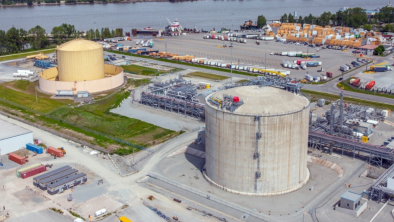BC’s Hydroelectric Dam to Support LNG Exports
Natural Gas Intel
The British Columbia (BC) government Tuesday launched construction of a C$8.3-billion ($7.5-billion) hydroelectric dam on the Peace River to support liquefied natural gas (LNG) exports via the province’s Pacific coast.
Six weeks after BC Hydro signed a power supply deal for LNG Canada’s proposed tanker terminal, the Liberal cabinet authorized the government-owned utility to build the 1,100 MW dam at a spot known as Site C, in the heart of the province’s gas fields.
In announcing the January construction start, Premier Christy Clark and Energy Minister Bill Bennett made no mention of any connection between the dam and the 18-entry lineup to build LNG export terminals for northern shale gas.
Instead, Clark and Bennett recited predictions that the Site C development will give consumers savings of C$650-900 million ($585-810 million) per year compared to more expensive, less reliable alternative power sources such as wind turbines.
But provincial politicians emphasized the supportive role low-cost electricity plays for industrial development when BC Hydro made its supply deal on Nov. 5 with the LNG Canada consortium led by a unit of Royal Dutch Shell plc and partners PetroChina, Korea Gas Corp. and Mitsubishi Corp. (see Daily GPI, Nov. 10).
As a power supply for refrigerating gas into liquid form for tanker exports, the agreement “is an important step forward toward getting the LNG industry up and running," said Clark. "It's about providing certainty for one of British Columbia's largest and most promising proposals.”
Natural Gas Development Minister Rich Coleman said the province is “committed to provide LNG proponents with sufficient energy for their operations while protecting rates for British Columbians. We are implementing that plan.
“LNG Canada will invest in new infrastructure to upgrade BC Hydro’s grid while helping to keep rates low for existing customers."
BC Hydro president Jessica McDonald said, “Electricity is the backbone of our economy. For decades, BC Hydro has powered industry in BC with clean, renewable electricity while maintaining among the lowest rates in North America...This new agreement provides greater certainty on future load growth while delivering long- term benefits for our customers."
The 1,100 MW dam advanced swiftly into the construction stage after finishing a seven-year regulatory ordeal that ended Oct. 16, when federal and provincial environmental authorities granted approvals subject to about 80 conditions.
Site C, named after its status as the third Peace River dam, is a seven-kilometer (four-mile) stroll southwest of the BC gas- and oilfield operations capital, Fort St. John. Locations for inlets to new pipelines proposed to fill LNG terminals are also nearby.
BC Hydro said its polls show 20% of the provincial population supports its project. But the dam approval further inflames the notoriously hot regulatory scene in the province, which is nationally celebrated as the Canadian front line of environmental and aboriginal resistance against all industry and government projects.
In the two months since the Oct. 16 environmental approvals, the Site C project has attracted six protest lawsuits filed by native, eco-warrior and northern landowner groups. In addition, BC and national aboriginal organizations have warned that fights against the dam will spill over into still comparatively quiet regulatory reviews of LNG projects.
The BC Wilderness Committee boils the battle down into conservation resistance against greedy development.
“Site C is not about meeting the electricity demands of British Columbians,” the eco-coalition said. “It is about subsidizing BC’s oil and gas and mining industries. It’s an C$8 billion taxpayer subsidy to a dirty fossil fuel industry that needs cheap energy to expand.”


